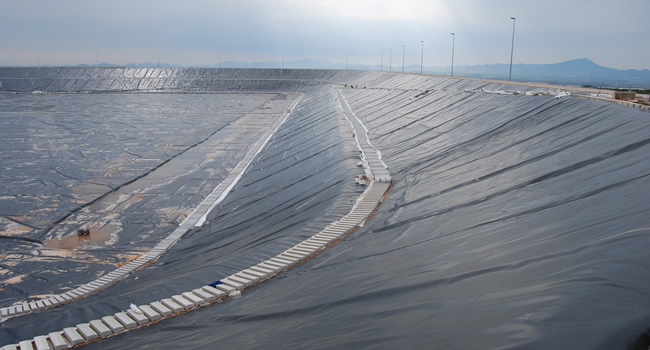Geosynthetic products have become an essential part of some key industries that often are the cornerstones for a country’s economy. Such industries include construction, mining, oil and gas and water. When compared to traditional alternatives, price and physical properties of geosynthetics are significant advantages. Geosynthetics are constructed from a variety of man-made polymers and are used in combination with soil or rock to improve terrain stability. Because of their capacity to tackle a variety of technical challenges relating to soil reinforcement, erosion control, and containment, these products are employed in civil, mining, and transportation infrastructure projects. There are four categories of geosynthetic products, geomembranes, geotextiles, geocells, and geocomposites. Geomembrane is the most common of these materials.
Geomembranes
Geomembranes are impermeable geosynthetic materials made up of thin continuous polymer sheets. Geomembranes form an impenetrable barrier that prevents hazardous contaminants and toxic chemicals from leaking into the environment. It’s also frequently utilized as a leak-proof containment barrier for potable water and irrigation storage needs. In mining, sewage treatment, and canal construction projects, geomembranes are used in conjunction with other geosynthetic products to control fluid movement and provide containment. Reports and Data estimates that the geomembrane market size will reach USD 4.45 billion by 2026, registering a CAGR of 9.5% as application of geomembranes in various infrastructure projects continues to increase.
To identify the key trends in the industry, click on the link below: https://www.reportsanddata.com/report-detail/geomembrane-market
Applications of Geomembranes
Because of the product’s adaptability, geomembranes are increasingly being used in a variety of sectors. Geomembranes are used in a variety of industries, including mining, marine, civil engineering, water treatment, and transportation. The following are some of the applications.
Mining Industry
The use of geomembrane in the mining industry began in the 1970s and has grown since then. Evaporation ponds, heap leach pads, and tailing impoundments all employ it as a lining solution. Because the design and construction of these heap leach pads are regulated to safeguard the environment from dangerous chemicals, a lining system, often a geomembrane, is a vital component in heap leach facility development.
Geomembranes are also utilized when a mine’s lifecycle is coming to an end. HDPE liners are used to seal the mine and prevent waste products from contaminating the environment as part of mine restoration. Overall, geomembrane lining is a safe and practical way to keep the environment secure from dangerous industries.

Water Industry
Geomembranes are critical in delivering safe drinking water to the population. They’re employed in drinking water and wastewater treatment, as well as sewage treatment. Groundwater pollution is avoided when geomembrane liners are used to seal canals, dams, and reservoirs.
Geomembrane is also used to protect potable water from contamination by soil and other pollutants, as well as to reduce water loss due to penetration into the surrounding soil. Lining a dam or canal helps reduce seepage, increasing storage and transportation efficiency. For subsurface storage tanks, solar ponds, and brine solution, geomembranes are also employed as a secondary containment.

Maritime Industry (Pontoon Construction)
Geomembranes are widely employed in the marine industry, particularly in the building of pontoon-supported floating docks or jetty platforms. Geomembrane is wrapped over the pontoon’s flotation foam throughout the construction process to offer a protective barrier and boost the product’s longevity. The foam is protected from harm caused by marine life, environmental pressures, and other contaminants in the ocean by being lined with a geomembrane. It also improves the pontoon’s overall longevity by adding greater buoyancy and preventing deterioration from extreme weather conditions.

Nurseries and Agriculture
Farmers commonly utilize liners to line dams and ponds because they are cost-effective and reliable containment solutions. Geomembranes are also utilized in nurseries for a variety of purposes, including soil confinement and waterproofing. As consumers move away from PVC and LDPE liners, commercial nurseries are increasingly employing HDPE liners. Gardeners, for example, are increasingly interested in HDPE geomembranes as a long-term solution for nursery bed lining and basket lining. Due to the product’s adaptability and durability, HDPE liners are also used to offer secondary containment in chemical and fertilizer storage tanks.

Oil and Gas Industry
The United States Environmental Protection Agency, or EPA, mandates that all establishments storing substantial volumes of petroleum products have a spill strategy in place. In applications involving oil or other dangerous or combustible compounds, secondary containment should always be provided. In the event of a leak or spill, containment with geomembrane liners is a cost-effective solution for cleanup. Secondary containment helps prevent polluting of land and water by hazardous liquids from the oil, gas, and mining sectors. Secondary containment also adds a second layer of protection to storage systems. It also holds flammable, reactive, poisonous, combustible, or corrosive compounds. Secondary containment provides numerous advantages, including decreased insurance costs and reduced liability risks. Secondary containment using geomembrane liners can assist oil, gas, and mining companies cut costs, improve safety, and mitigate facility and environmental damage. Secondary containment is critical for environmental protection and product preservation during storage and transit.

Conclusion
Geomembranes are utilized in the garbage sector, as well as in environmental, hydraulic, transportation, and oil and gas applications. Continuous polymeric sheets are the most prevalent form of geomembranes. For increased strength and longevity, large geomembranes are thermally or chemically welded together at the seams.

